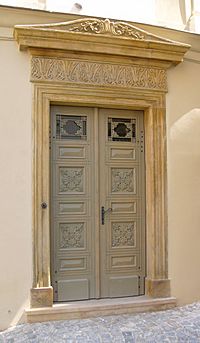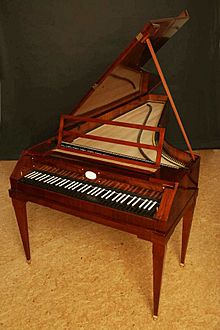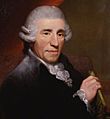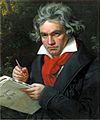Classical period (music) facts for kids

The dates of the Classical period in Western music are generally accepted as being between about the year 1730 and the year 1820. However, the term classical music is often used in a colloquial sense as a synonym for Western art music which describes a variety of Western musical styles from the Middle Ages to the present, and especially from the seventeenth century to the nineteenth.
The Classical period falls between the Baroque and the Romantic periods. Classical music has a lighter, clearer texture than Baroque music and is less complex.
The best-known composers from this period are Joseph Haydn, Wolfgang Amadeus Mozart, Ludwig van Beethoven, and Franz Schubert; other notable names include Luigi Boccherini, Muzio Clementi, Antonio Salieri, Leopold Mozart, Johann Christian Bach, Carl Philipp Emanuel Bach, and Christoph Willibald Gluck. Ludwig van Beethoven is regarded either as a Romantic composer or a Classical period composer who was part of the transition to the Romantic era.
Contents
Classicism

In the middle of the 18th century, Europe began to move toward a new style in architecture, literature, and the arts, generally known as Classicism. This style sought to emulate the ideals of Classical antiquity, especially those of Classical Greece. Classical music was still tightly linked to aristocratic Court.
The new style was also encouraged by changes in the economic order and social structure. As the 18th century progressed, the nobility became the primary patrons of instrumental music, while public taste increasingly preferred lighter, funny comic operas.
While vocal music such as comic opera was popular, great importance was given to instrumental music. The main kinds of instrumental music were the sonata, trio, string quartet, symphony, concerto (usually for a virtuoso solo instrument accompanied by orchestra), and light pieces such as serenades and divertimentos. Sonata form developed and became the most important form. It was used to build up the first movement of most large-scale works in symphonies and string quartets.
Mozart's arrival in Vienna in 1780 brought an acceleration in the development of the Classical style. There, Mozart absorbed the fusion of Italianate brilliance and Germanic cohesiveness that had been brewing for the previous 20 years. It was during this decade that public taste began, increasingly, to recognize that Haydn and Mozart had reached a high standard of composition. During this decade Mozart composed his most famous operas, his six late symphonies that helped to redefine the genre, and a string of piano concerti that still stand at the pinnacle of these forms.
Classical period instruments
Strings
In the Baroque era, there was more variety in the bowed stringed instruments used in ensembles, with instruments such as the viola d'amore and a range of fretted viols being used, ranging from small viols to large bass viols. In the Classical period, the string section of the orchestra was standardized as just four instruments:
- Violin (in orchestras and chamber music, typically there are first violins and second violins, with the former playing the melody and/or a higher line and the latter playing either a countermelody, a harmony part, a part below the first violin line in pitch, or an accompaniment line)
- Viola (the alto voice of the orchestral string section and string quartet; it often performs "inner voices", which are accompaniment lines which fill in the harmony of the piece)
- Cello (the cello plays two roles in Classical era music; at times it is used to play the bassline of the piece, typically doubled by the double basses [Note: When cellos and double basses read the same bassline, the basses play an octave below the cellos, because the bass is a transposing instrument]; and at other times it performs melodies and solos in the lower register)
- Double bass (the bass typically performs the lowest pitches in the string section in order to provide the bassline for the piece)
Woodwinds
Keyboards
- Clavichord
- Fortepiano (the forerunner to the modern piano)
- Piano
- Harpsichord, the standard Baroque era basso continuo keyboard instrument, was used until the 1750s, after which time it was gradually phased out, and replaced with the fortepiano and then the piano. By the early 1800s, the harpsichord was no longer used.
Brasses
- Buccin
- Ophicleide – replacement for the "serpent", a bass wind instrument that was the precursor of the tuba
- French horn
- Trumpet
- Trombone
Role of women
Almost all of the composers who are described in music textbooks on the classical period and whose works are widely performed as part of the standard concert repertoire from the classical period are male composers, even though there had been a large number of women composers throughout the classical music period.
Images for kids
-
A modern string quartet. In the 2000s, string quartets from the Classical era are the core of the chamber music literature. From left to right: violin 1, violin 2, cello, viola
-
Gluck, detail of a portrait by Joseph Duplessis, dated 1775 (Kunsthistorisches Museum, Vienna)
-
Haydn portrait by Thomas Hardy, 1792
-
The opening bars of the Commendatore's aria in Mozart's opera Don Giovanni. The orchestra starts with a dissonant diminished seventh chord (G# dim7 with a B in the bass) moving to a dominant seventh chord (A7 with a C# in the bass) before resolving to the tonic chord (D minor) at the singer's entrance.
-
Portrait of Beethoven by Joseph Karl Stieler, 1820
-
View of Vienna in 1758, by Bernardo Bellotto
See also
 In Spanish: Música del Clasicismo para niños
In Spanish: Música del Clasicismo para niños












